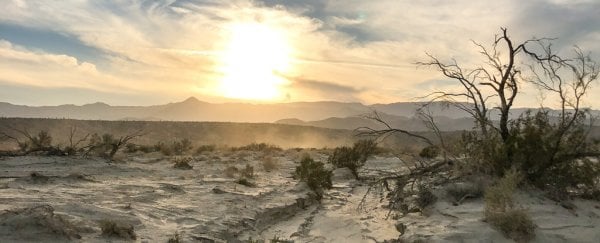In normal times, it’s easy to assume that desert plants will weather tough periods. These hardy organisms evolved to survive bouts of prolonged heat and dryness, after all. They can take it.
These are not normal times, though. A new study analyzing over 30 years’ worth of satellite imagery captured over southern California reveals that plant life in parts of the giant Sonoran Desert has declined by over one-third in recent decades.
In the period of 1984 to 2017, vegetation cover in Anza-Borrego State Park – California’s largest state park – diminished by 35 percent, the measurements suggest.
“Plants are dying, and nothing’s replacing them,” says project scientist Stijn Hantson from the University of California, Irvine. “It looks to be a striking loss for shrubs.”
(Sicco Rood/Steele/Burnand Anza-Borrego Desert Research Center)
Above: An ocotillo forest in Anza-Borrego Desert in Southern California.
While the findings are concerning, they are not altogether unexpected.
In recent years, a number of studies have charted drought-related vegetation loss in arid regions of the Southwestern US – including in the Sonoran Desert specifically, which straddles California, Arizona, and parts of Mexico.
“These vegetation mortality events seem to exceed natural variability in background mortality rates, as some [dryland plant] species have experienced up to 100 percent mortality, possibly leading to local extinction,” Hantson and his co-authors explain in their new paper.
Despite these grim signals, it’s still not yet fully understood how climate change might be driving plants to die off in dryland ecosystems, which cover over 40 percent of Earth’s terrestrial surface.
To investigate within the Sonoran Desert context, the researchers analyzed Landsat satellite imagery, looking for spectral patterns in the Anza-Borrego State Park landscape, where sunlight reflected by plant leaves gives an indication of how green an area is.
The results showed a particularly widespread decline over the past four decades in perennial vegetation cover in lowland deserts – populated by creosote bush (Larrea tridentata), various cactus species, and mesquite (Prosopis sp.) in some areas.
Comparably lower losses were seen in higher elevation areas, which are covered by montane woodlands, juniper and pinyon woodlands, chaparral, and high desert vegetation, the researchers say.
Overall, 87.1 percent of the study area showed a downward trend, the researchers say, with the die-offs attributed to a combination of warmer temperatures and lower rainfall in prolonged drought conditions – both linked to human-caused global warming.
“The observed trends are consistent with the hypothesis that warming temperatures have caused a long-term increase in water limitation,” the researchers write.
“This is especially clear across the lowland deserts, which are the driest areas of the study domain, and is superimposed against high levels of interannual variability in precipitation.”
The findings suggest that plants typically growing in hot, arid places – known for their ability to withstand extreme environmental conditions – are now being pushed beyond their considerable limits, with their harsh habitat making them early plant casualties on the frontlines of climate change.
“They’re already on the brink,” Hantson says.
Indeed, the research indicates that lowland desert areas may have already crossed an “ecological threshold” around the turn of the century, leading to mass vegetation mortality in response to new temperature extremes paired with lower precipitation.
Exactly what that means for the future of dryland plants remains unknown, but the signs are not encouraging so far, and threaten to challenge our confidence in the resilience of arid ecosystems everywhere.
“The desert might be more fragile than people assume,” Hantson told The Academic Times.
“It really seems like the vegetation is going to take a long time to recover, if it ever recovers, under the new climate conditions.”
The findings are reported in Journal of Geophysical Research: Biogeosciences.
